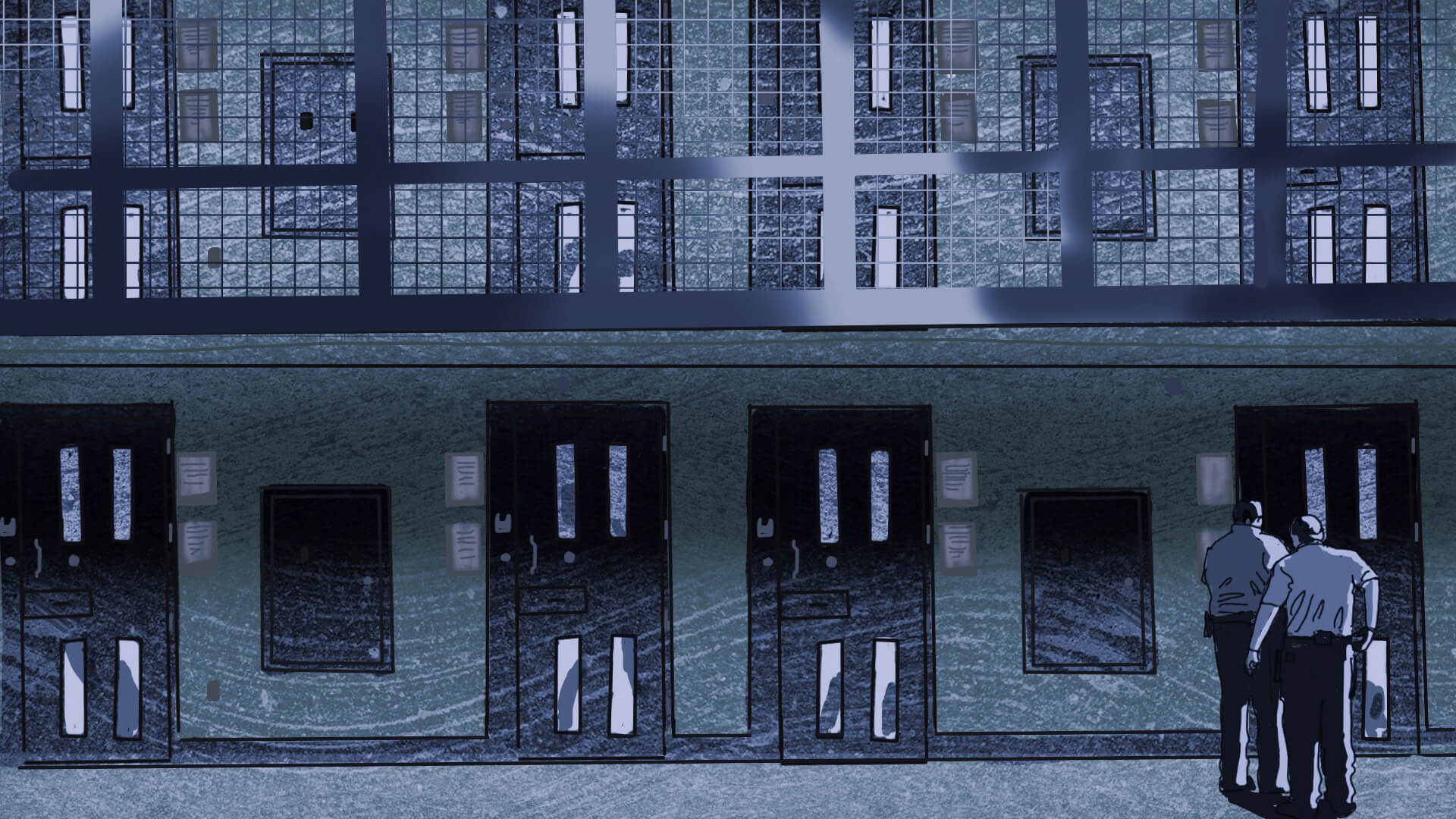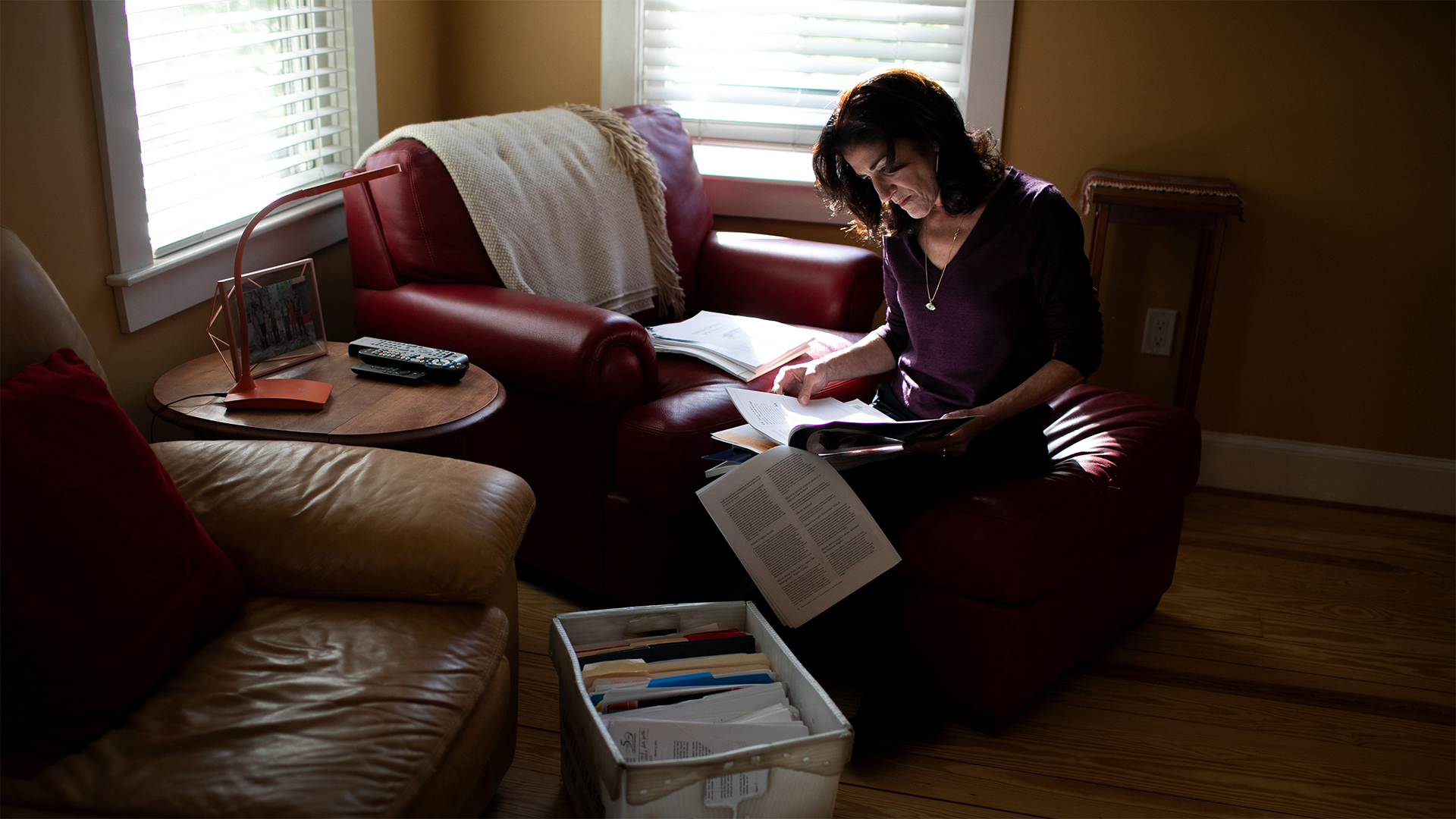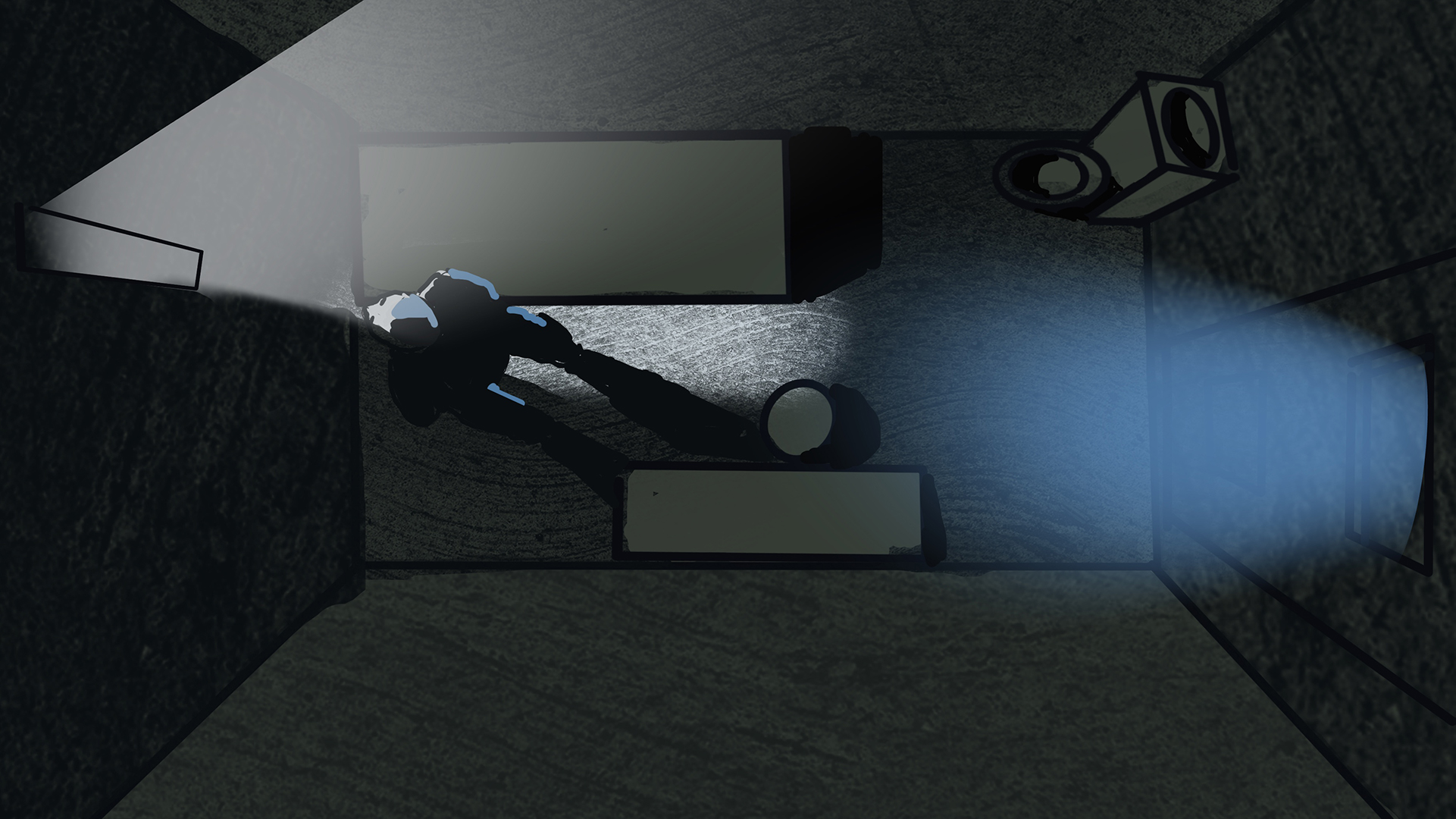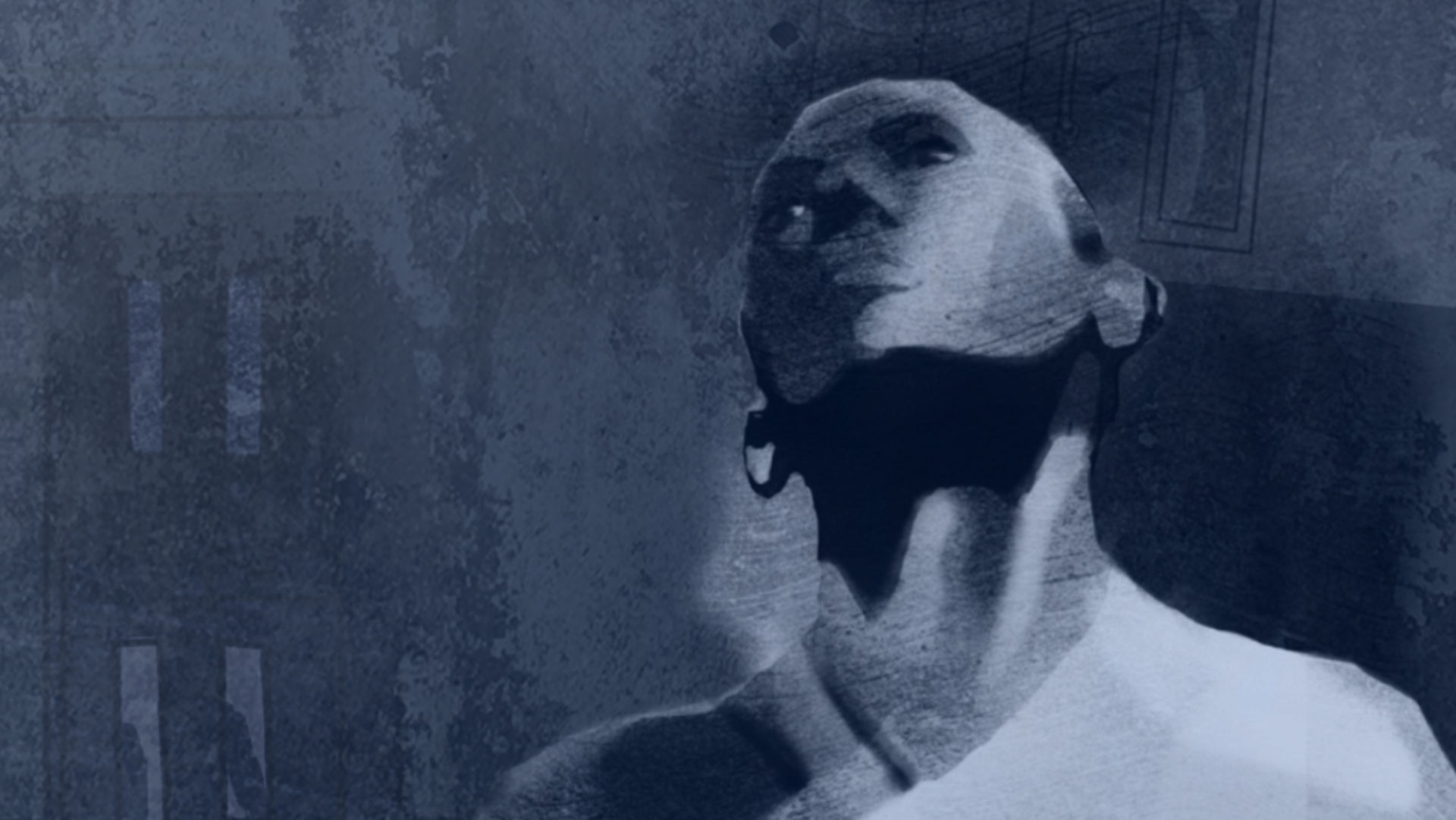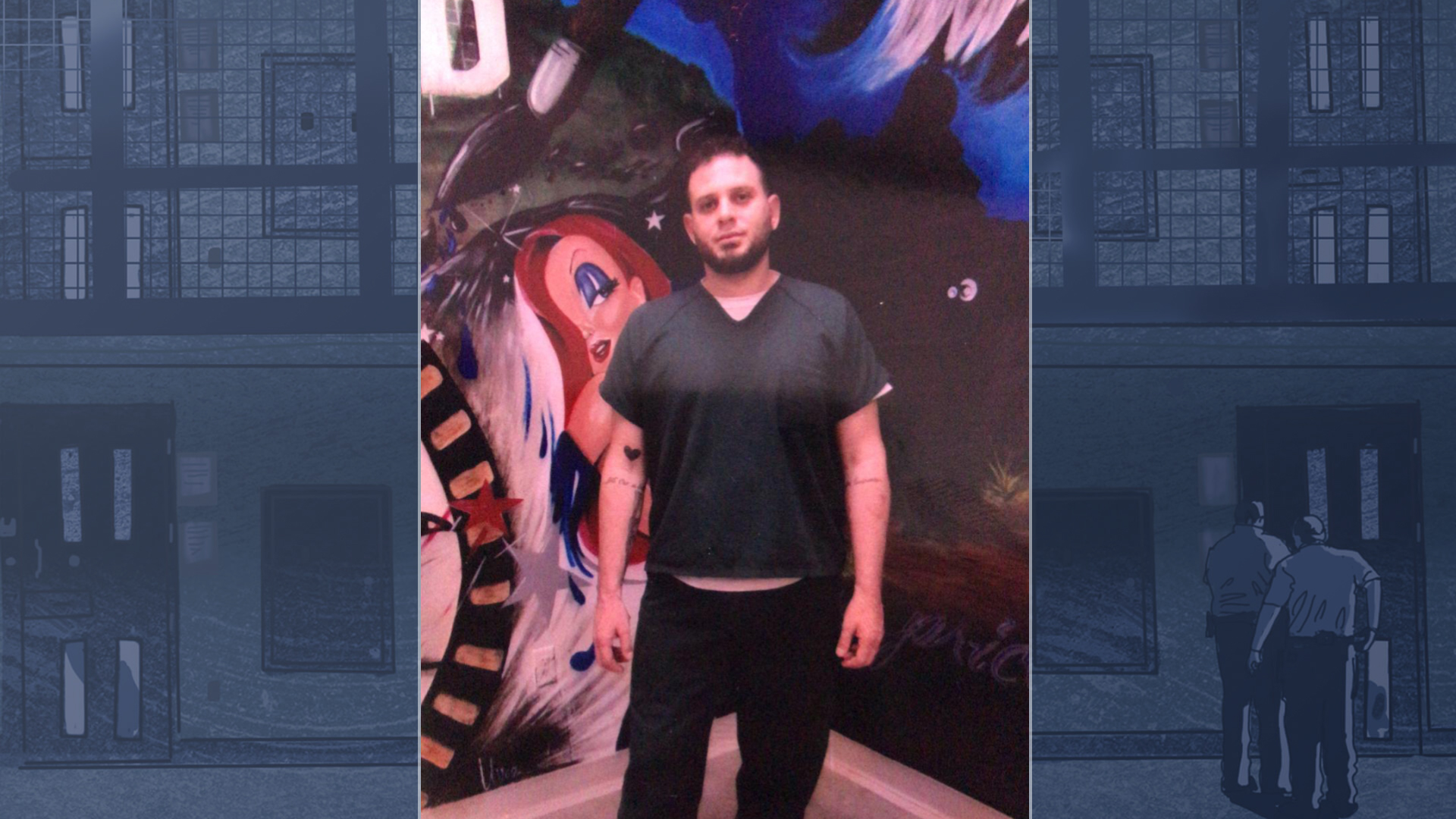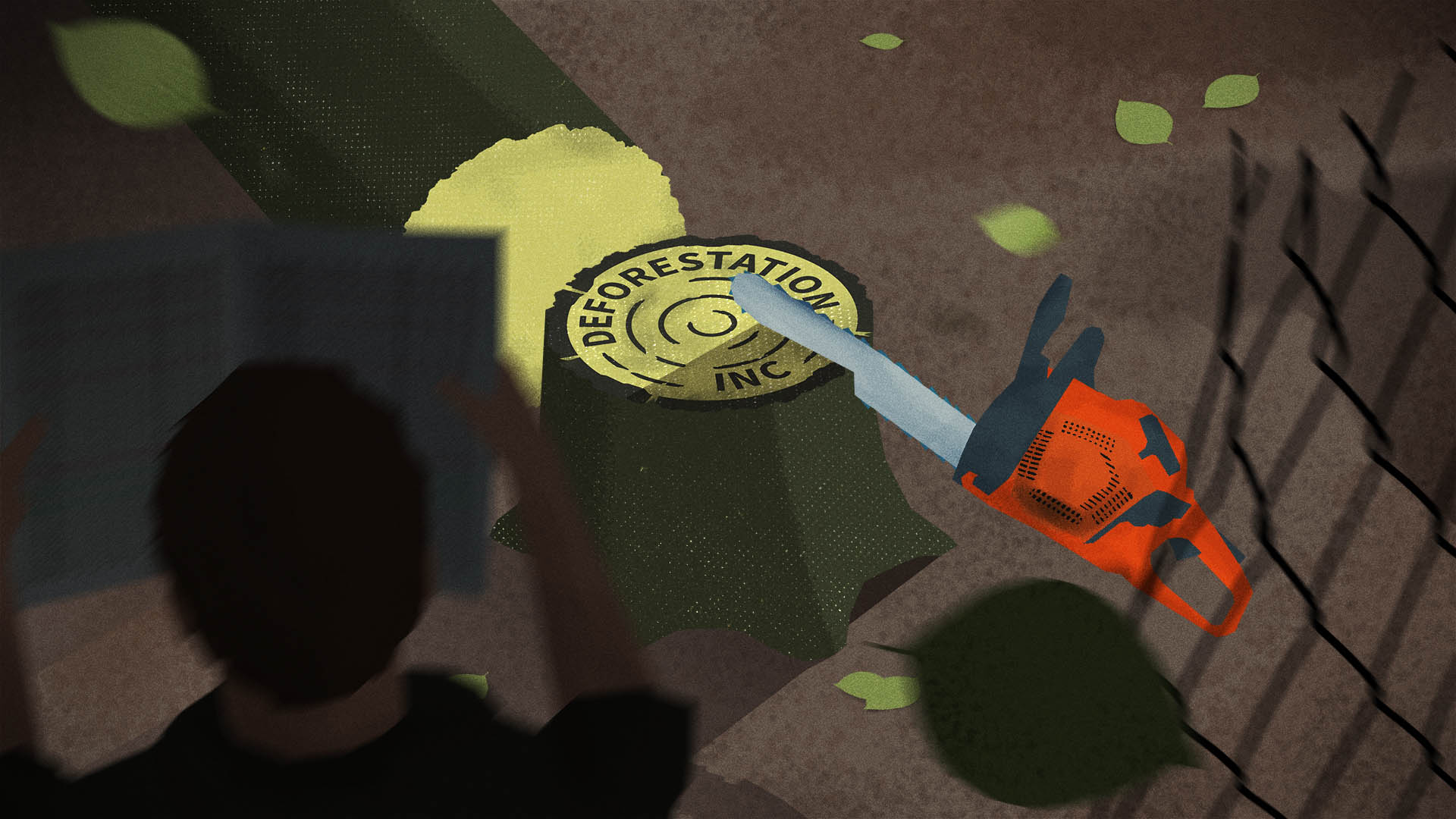
Dulce Rivera lived for the one hour a day she was allowed outside, to pace alone on a patch of concrete encased by metal fencing.
They called it “the yard,” but it was really a metal cage. Still, it was far better than the misery she endured the other 23 hours a day, locked alone in a cell with no one to talk to, and nothing to distract her from her increasingly dark thoughts.
Rivera, a 36-year-old transgender woman from Honduras and a longtime United States resident, was detained by U.S. Immigration and Customs Enforcement in 2017. She was placed in the Cibola County Correctional Center in New Mexico, and moved into solitary confinement in May of 2018 for harassing other detainees, according to facility records.
The cell had bare walls, adorned only with a few crude metal necessities: a table, sink and toilet.
“You never know what day it is, what time it is,” Rivera said. “Sometimes you never see the sun.”

On June 20, nearly four weeks after she was placed in isolation, guards told her that she wouldn’t be allowed to go to the yard. Two days later, she fashioned a noose from a torn blanket and hanged herself from a ceiling vent.
A passing guard cut her down before she suffocated, but her ordeal wasn’t over. After a trip to the hospital, immigration officials led Rivera back to a different solitary confinement cell — this one with huge block letters across the door reading “SUICIDE SAFE.”
Rivera would spend most of the next year in isolation, in the same conditions that she blames for her mental breakdown.
The United Nations special rapporteur on torture has said that solitary confinement should be banned except in “very exceptional circumstances” and that isolation for more than 15 days constitutes “inhuman and degrading treatment.” The mentally ill should never be put in isolation, the rapporteur said.
ICE’s own directives say that isolating its detainees — who under federal law, aren’t considered prisoners and aren’t held for punitive reasons — is “a serious step that requires careful consideration of alternatives.”
An investigation called Solitary Voices by the International Consortium of Investigative Journalists and partners in five countries has found that rather than as a last resort, ICE uses isolation as a go-to tool to manage and punish even the most vulnerable detainees for weeks and months at a time.
ICIJ’s reporting, which included a groundbreaking review of more than 8,400 reports describing placements of ICE detainees in solitary confinement, found that the immigration agency has used isolation cells to punish immigrants for offenses as minor as consensual kissing and to segregate hunger strikers, LGBTQ detainees and people with disabilities.
In nearly a third of the cases, detainees were described as having a mental illness, a population especially vulnerable to breakdown if locked up alone in a small cell. Records reviewed by ICIJ describe detainees in isolation mutilating their genitals, gouging their eyes, cutting their wrists and smearing their cells with feces.
The review found that while held in isolation cells, immigrants had suffered hallucinations, fits of anger and suicidal impulses. Former detainees told ICIJ they experienced sleeplessness, flashbacks, depression and memory loss long after release.
“People were being brutalized,” said Ellen Gallagher, a supervisor within the U.S. Department of Homeland Security who has tried for years to sound the alarm within the federal government about abusive use of solitary confinement by ICE, a DHS agency.
She has never been so deeply disturbed by a professional matter, she said. “I lost sleep. I cried,” she said.
Speaking publicly for the first time, Gallagher said she believes ICE’s use of solitary confinement “rises to the point of torture.”
ICIJ’s investigation was conducted over five months in collaboration with Grupo SIN in the Dominican Republic; Plaza Pública in Guatemala; Mexicanos Contra la Corrupción in Mexico; and The Intercept, NBC News and Univision in the U.S.
It comes in the midst of unprecedented public scrutiny of the way U.S. authorities arrest and detain asylum seekers and other immigrants. President Donald Trump’s tough stance has caused the population of ICE detention centers to swell, with more immigrants waiting behind bars as their cases languish in heavily backlogged immigration courts, though the routine use of solitary confinement long predates his presidency.
ICIJ’s investigation included interviews with dozens of detainees, and the review of thousands of pages of audits and other documents. The incident reports reviewed by ICIJ describe placements of detainees in solitary confinement from 2012 to early 2017 — adding up millions of hours of isolation.
ICIJ obtained the incident reports through a public records request that asked for logs detailing placements of detainees in solitary confinement. The records cover only a portion of all isolation stays in ICE facilities.
ICE said it does not keep records of every solitary confinement placement. Instead it tracks only those cases where detainees were held in isolation for more than 14 days, and where immigrants with a “special vulnerability” were placed in isolation. This latter category includes detainees who have a mental illness, have been victims of abuse or would be at risk in a facility’s general population due to their sexual orientation or gender identity.
More than half of the detainees in the data set are from just four countries: Mexico, El Salvador, Honduras and Guatemala, generally reflecting overall migration trends.
In a statement, ICE spokesperson Danielle Bennett said the agency’s policy on segregation — the ICE term for isolation — “protects detainees, staff, contractors, and volunteers from harm.” On average, half a percent of its population was held in solitary for 14 days or more in 2018, she said.
‘Gasoline on a fire’
Some detainees spent weeks or months in isolation.
More than half of the 8,488 incident reports ICIJ reviewed described stays in solitary confinement that lasted longer than 15 days. ICIJ identified 187 cases in which a detainee was held for more than six months. In 32 of those cases, the detainee was confined in solitary for a year or more.
An NBC News review of ICE detainee death reports found that at least 13 detainees who died in ICE custody had spent time in solitary, in some cases up to the time of death. In eight of those deaths, ICE later determined that rules for putting detainees in isolation and procedures for caring for them were not followed, according to agency documents.
ICIJ’s analysis found at least 373 instances of detainees being placed in isolation because they were potentially suicidal — and another 200-plus cases of people already in solitary confinement moved to “suicide watch” or another form of observation — in many cases in another solitary cell.
“This is the equivalent of pouring gasoline on a fire,” Kenneth Appelbaum, a professor emeritus of psychiatry at the University of Massachusetts Medical School who has examined ICE’s segregation practices as a DHS consultant, said of using solitary confinement to manage suicidal detainees. “This is a practice that exposes detainees to real psychological and physiological harm.”
Citing nondisclosure agreements with the agency, Appelbaum declined to comment specifically on what he saw at ICE.
Some ICE detention centers — such as Adelanto Detention Facility in California, run by the GEO Group, and Stewart Detention Center in Georgia, run by CoreCivic — reported placing hundreds of detainees in isolation. Both facilities are the subject of class-action lawsuits by former detainees alleging that the two private contractors used solitary confinement to force immigrant detainees to work for as little as a dollar a day.
In response to questions from ICIJ, both the GEO Group and CoreCivic said their work programs are strictly voluntary.
Other detention centers appear to use isolation rarely, though there is no way to tell whether a facility is misreporting or under-reporting incidents. (One of ICE’s government watchdogs, the DHS inspector general, has found significant problems with under-reporting of solitary confinement data).
The records show dozens of cases of detainees placed in solitary confinement solely due to a disability, many simply because they needed a wheelchair, cane, crutches or some other aid. One detainee from Guatemala was put in isolation for more than two months only because he had a prosthetic leg. A Nicaraguan man was put in solitary for almost two months. The only listed reason: “Detainee utilizes crutches — deformed leg.”
The logs also include 182 descriptions of detainees being isolated for going on hunger strike, a form of protest that advocates argue is protected under the First Amendment.
“It was mental torture, nothing else,” said Karandeep Singh, a 29-year-old Sikh from the Punjab state of northern India who was moved to solitary confinement in the El Paso Processing Center, in Texas, after he refused meals to protest his impending deportation. Singh said that after more than two weeks in solitary, he bashed his head into his cell wall in an attempt to kill himself.
Even months after being released from isolation, Singh and other former detainees said they couldn’t move past the experience.
“After that first or second week, I lost my mind,” said Ayo Oyakhire, a 52-year-old Nigerian, of his nearly seven weeks in isolation at the ICE unit in Atlanta’s jail. “Sometimes I feel like someone is choking me. I have flashbacks, like I’m still confined in that little room.”
Human rights crisis
The origins of solitary confinement date back to European dungeons in the Middle Ages, but the practice was not institutionalized until the rise of the modern penitentiary in the early 19th century. For jailers trying to manage unruly or dangerous prisoners, isolation cells proved a useful tool: Lock them inside an armored box where they can disturb no one but themselves.
Beginning with a raft of tough-on-crime laws in the 1970s, the use of solitary surged in the U.S., along with a major boom in its prison population. In 2016, Amy Fettig, head of the American Civil Liberties Union’s Stop Solitary campaign, wrote that the use of solitary confinement in America “is a global outlier and human rights crisis.”
Most of the attention paid to solitary confinement has focused on prisons. Its use in immigration detention centers has drawn far less notice.
In 1993, at the start of Bill Clinton’s presidency, a handful of U.S. detention centers held a few thousand immigrant detainees on any given day. Clinton signed into law new requirements that mandated detention of many immigrants who had served prison time and tripled the size of the detention network.
By the time of President Barack Obama’s inauguration in 2009, civil detention of noncitizens had joined the mainstream of U.S. incarceration, with large private-sector prison companies competing for multimillion-dollar federal contracts to help detain tens of thousands of immigrants. A network of new facilities sprawled across dozens of states — many operated by private contractors or situated within county jails.

In February 2014, Gallagher, the whistleblower, then a policy adviser for Homeland Security’s Civil Rights and Civil Liberties office, came across ICE logs detailing the placement of detainees in solitary confinement. At first, she couldn’t believe her eyes: The agency was using the punishing conditions of isolation on civil detainees routinely and often with little apparent justification.
Her alarm grew as she gathered more documentation and reviewed cases of ICE detention centers placing mentally ill immigrants in isolation for attempting suicide and for being the victim of a physical attack. One detainee was placed in isolation for the unauthorized possession of a green pepper.
Over several months, Gallagher tracked individual cases and gathered reams of documentation. Coming to believe that ICE was violating its own rules and endangering the lives of detainees, she embarked on a years-long effort to reform the agency’s practices.
In a succession of whistleblower memos first circulated internally at DHS and then sent to the U.S. Office of Special Counsel — an independent agency where federal employees can file complaints of wrongdoing they think have been ignored — Gallagher alleged that abuses of solitary confinement at ICE had become “urgent and at times life-threatening” and that the practices contributed to an “ongoing abuse of authority and create a substantial and specific danger to public health and safety.”

ICE’s internal guidelines explicitly require detention officials to document what alternatives to isolation were considered in certain cases. Gallagher often found no evidence that ICE had actually done this.
While a breach of ICE’s directive, by itself, would not amount to a legal violation, departing from agency rules can still be highly significant, said Lucas Guttentag, a professor of law at Stanford University. “The directive is effectively internal agency law that every employee and manager must follow with care and fidelity,” Guttentag said. “Directives are critical to governing an agency effectively.”
In a statement, the Department of Homeland Security said that its Office for Civil Rights and Civil Liberties had examined ICE’s use of isolation through complaint investigations, working groups and other advice and feedback. The office has worked with ICE “to improve policy and reduce unnecessary use of segregated housing for ICE detainees,” a spokesperson said. The office said that, in 2016, it collaborated with ICE to implement Obama-era recommendations issued by the Justice Department on improving solitary confinement.
DHS’s Office of Inspector General, which Gallagher also communicated with during her whistleblowing — and where she now works as a director in the Office of Integrity and Quality Oversight — pointed to several critical audits it had conducted of ICE facilities since 2016, including one report that focused specifically on the use of segregation and recommended better data-collection practices.
Perhaps the most meaningful step taken in response to Gallagher’s whistleblowing was a previously unreported letter sent in June 2015 by the Senate Judiciary Committee’s chairman at the time, Sen. Charles Grassley, an Iowa Republican, and a Democrat on the panel, then-Sen. Al Franken of Minnesota. The letter was addressed to Jeh Johnson, who was the homeland security secretary.
“Recent information obtained by the Committee,” the senators wrote, “suggests that ICE continues to place many detainees with mental health concerns in administrative or disciplinary segregation — also known as solitary confinement — contrary to agency directives that limit the use of segregation for the mentally ill.”
Believing she has exhausted her options for whistleblowing within the government, Gallagher agreed to share her story with ICIJ. Without public action, “this same set of circumstances will not stop,” Gallagher said. “And I think it will actually get worse.”
‘The suicide room’
Rivera has led a troubled life. Although her birthplace is unknown, her earliest memories are of the streets of San Pedro Sula in Honduras. She said her mother, a prostitute, abandoned her to fend for herself at age 10. Rivera said she suffered abuse on the streets and began using drugs at an early age. Fleeing destitution in Central America, she arrived in the U.S. when she was 16 and was later granted permanent residency.
In 2013, she was convicted in Santa Barbara, California, of robbery in the second degree, an aggravated felony, according to immigration court filings. She spent the next four years in prison before being transferred to ICE custody.
ICE maintains that while detained in New Mexico, Rivera harassed other detainees, an allegation she denies.
After the suicide attempt, she was put in a new solitary confinement cell that was much like her first, but this time she was stripped and given a heavy green smock that couldn’t be torn or otherwise fashioned into an instrument of self-harm.
She was still locked alone almost all of the time in conditions that caused her mind to fester. “They take off all your clothes, and they put you in a cell that is more terrible,” Rivera said.
ICIJ found that there is often a revolving door between solitary confinement and medical isolation cells for people deemed at high risk of trying to hurt themselves. Like Rivera, Karandeep Singh, the Indian hunger striker, was also moved again to isolation after he tried to kill himself. He said he remained in what he calls the “suicide room” for 24 hours in handcuffs, and was then placed in a smock, like Rivera.
In one memo, Gallagher describes seeing records of ICE detainees moving “chronically back and forth from the general population to administrative or disciplinary segregation, with periodic, crisis-oriented admissions to psychiatric hospitals punctuating their return to the same disturbing cycle.”
The records ICIJ reviewed contain numerous examples. In Michigan’s Calhoun County, after an Iraqi detainee was admitted to a hospital for cutting himself with a razor, detention officials placed him in suicide watch and then charged him with “a weapons offense and self mutilation,” sentencing him to 30 additional days in isolation, otherwise known as Special Housing Unit, or SHU, as punishment.
Nobody should be on ‘dead time’ in solitary, meaning they perceive that there is nothing to do and nothing will improve their situation. – Terry Allen Kupers
In the agency’s response, ICE spokesperson Bennett said agency standards permit it to place potentially suicidal people in isolation as a last resort. “Due to housing limitations at various facilities, segregation use for suicide observation is a necessity,” Bennett said.
ICE standards also permit it to use isolation cells to allow medical staff to monitor detainees on hunger strike when necessary, Bennett said.
Even some of the toughest critics of solitary confinement acknowledge that it can be necessary to separate people from the general population of a jail or detention center for a short time. It can be for their own protection — or to protect others, if a detainee, for instance, is experiencing a fit of violent anger. But experts and human rights advocates say that solitary confinement placements should be rare, and last as short a time as possible.
When action must be taken, facilities can first require mediation or anger-management classes, or take away privileges, such as television time, experts say. Detainees at risk of harm could be transferred to other units or facilities that have more accommodating populations. If isolation is necessary, detainees should be permitted meaningful contact with others for multiple hours a day, and given a clear roadmap indicating what they must do to be let out.
“Nobody should be on ‘dead time’ in solitary, meaning they perceive that there is nothing to do and nothing will improve their situation,” said Terry Allen Kupers, a psychiatrist and professor at The Wright Institute who has studied solitary confinement extensively.
ICE documentation suggests that the detention center put Rivera in the suicide watch isolation cell as a form of punishment intended to change her behavior.
“She has finally begun to reflect upon her actions,” noted a mental health worker at the facility. “[Rivera] admitted that her actions have cost her a lot and she didn’t realize how well she actually had it (even in SHU) until being back now [on suicide] watch again.”
Experts say using solitary confinement as a way to manage suicidal detainees is unacceptable. “The only way to respond to suicidal prisoners and help them is to talk to them, to have an evolving therapeutic relationship,” Kupers said. “That’s how we treat suicide in any setting.”
In August 2018, ICE moved Rivera to El Paso. There, the transgender woman was given the option of rooming in the general population — or alone, in an isolation cell, according to ICE records. (Rivera disputes that she was offered a choice).
Many case logs reviewed by ICIJ indicate that a detainee requested an isolation cell for their own protection. Wes Brockway, Rivera’s attorney, said asking detainees to decide between the threat of violence and the misery of isolation is no choice at all.
“We’re giving the option of being in a population where they might not be safe or going into conditions where they’re extremely isolated and almost guaranteed to suffer psychological harm,” he said. “It’s completely contrary to the idea of protecting someone.”
Citing a 2015 agency guidance on the treatment of transgender detainees, ICE said it weighs housing options for such individuals with a multidisciplinary team of that can include mental health staff and subject matter experts. The agency said that transgender detainees should be placed in segregation only as a last resort and when no other housing options are available.
CoreCivic, which runs the Cibola facility, said that it is contractually required to follow ICE’s detention standards. “We’re committed, as we have been for three decades, to creating a safe environment for the individuals ICE entrusts to our care,” CoreCivic spokesperson Amanda Gilchrist said, “and to following all federal guidelines on the appropriate accommodation of transgender detainees.”
In El Paso, Rivera spent nearly eight months in solitary confinement, mostly under protective custody. On April 9, she was abruptly released from the detention center altogether.
Solitary confinement as punishment
In the incident reports reviewed by ICIJ, “disciplinary segregation” — punishment for breaking the rules — was the single reason most often given for putting a detainee in solitary confinement.
The infraction most often cited was fighting. Disputes over stolen shampoo bottles and what television channel to watch sometimes boiled over into physical altercations in the reports ICIJ reviewed.
Scattered throughout the reports are descriptions of people being placed in solitary confinement for what seem like minor infractions.
One detainee was placed in isolation for giving haircuts. Another spent 13 days in isolation for consensually kissing another detainee. A third, despite having a mental illness, remained in solitary for 41 days for encouraging other detainees to go on hunger strike.
A 2017 audit by the inspector general’s office for the Homeland Security Department identified “problems that undermine the protection of detainees’ rights, their humane treatment, and the provision of a safe and healthy environment.” ICE detention centers were placing detainees in solitary confinement for infractions as minor as improperly sharing a cup of coffee, the audit found. In some cases, the watchdog pointed out, detainees were punished with solitary because they were suspected of having committed an infraction that officials needed time to investigate.
Ilyas Muradi, a 30-year-old longtime U.S. resident from Afghanistan, has spent most of the last four months in solitary at ICE’s South Texas Detention Complex. He said he was accused of entering a shower without authorization, and threatening a guard.
Muradi denied that he threatened a guard, but acknowledged having gotten into multiple fights with other detainees last year. He said he believes guards are now punishing him simply because they don’t like him — and is frustrated because he doesn’t know what he can do to be released from solitary.
“I don’t know what’s going on,” Muradi said. At the end of one call to ICIJ, Muradi lost his usual composure, breaking into sobs, asking, “Can you please help me?”
In recent years, some state prison systems in the U.S. have taken steps to limit the use of solitary confinement to discipline inmates for violating facility rules. Texas, where Muradi is detained, outlawed the practice in its correctional institutions. The state’s prisons use solitary confinement only in cases in which a detainee presents a threat due to gang affiliation or other security risks.
In ICE detention, by contrast, disciplinary isolation is sometimes used to segregate the victim of an attack.
In mid-April 2017, a 27-year-old detainee named Jeancarlo Jimenez-Joseph at ICE’s Stewart Detention Center in Lumpkin, Georgia, was placed in solitary confinement for several days for fighting. Video surveillance footage shows Jimenez-Joseph being attacked by another detainee and feebly defending himself.
Not long after he was released from solitary confinement for the fight, Jimenez-Joseph was back in solitary as punishment for jumping off a second-level balcony — an action he told staff was aimed at hurting no one but himself.
After 18 days in segregation, he hanged himself using a sheet tied to a sprinkler head in his small cell.
In a statement, CoreCivic, which runs the Stewart facility, said that it was not responsible for health services at the facility at the time of Jimenez-Joseph’s death.
Lasting trauma
In the middle of April, on a park bench set back from the din of Amritsar, India, a temple-dotted city near the Pakistan border, Karandeep Singh lifted a pristine New York Yankees baseball cap and pointed to a two-inch scar slanting up from his right eyebrow toward his hairline. It is a reminder of his attempt to end his life in solitary.
The cut has closed, but Singh, who was deported to India in late February, said his mental wounds have been slower to heal. “I am mentally elsewhere. I cannot sleep,” Singh said. He said he has flashbacks that trigger the fear he felt in solitary confinement in Texas. “You are changed, you can’t feel safe,” Singh said.
ICE detainees who recounted their experiences to ICIJ and its partners gave remarkably similar descriptions of the lasting trauma of solitary confinement.

They spoke of a feeling cell-bound long after their release; of insomnia; of suffering vivid flashbacks of isolation, particularly at night; of grappling with depression and memory loss.
Manpreet Singh, a 30-year-old detainee and acquaintance of Karandeep, said ICE placed him in solitary for going on hunger strike at the agency’s facility in Otero County, New Mexico. Singh said he suffers flashbacks at night and has lost interest in socializing. “I don’t talk to people much anymore,” he said.
After her release on April 9, Dulce Rivera moved into the Las Cruces, New Mexico, home of a visitation volunteer she had grown so close to in detention that she calls her “Mom.”
She now has her own bedroom, with windows that let in the morning light. But at night, the fear creeps back in. She has recurring nightmares, disorientation and trouble sleeping. And when she goes to bed, she leaves the door open.
Global crisis support resources can be found via the International Association for Suicide Prevention.
Contributors: Emilia Diaz-Struck, Scilla Alecci, Ben Hallman, Richard H.P. Sia, Fergus Shiel, Tom Stites, Hamish Boland-Rudder, Amy Wilson-Chapman, Pauliina Siniauer, Antonio Cucho, Andrew Lehren, Vanessa Swales, Alicia Ortega, Julia Ramírez, Enrique Naveda, Suchit Chávez, Alejandro GarcíaValeria Durán & Daniel Lizárraga, Andrew Lehren, Hannah Rappleye, Vanessa Swales, Maryam Saleh, Lynn Dombek, Talya Cooper, Roger Hodge, Ariel Zambelich, Moiz Syed, and Tamoa Calzadilla.
